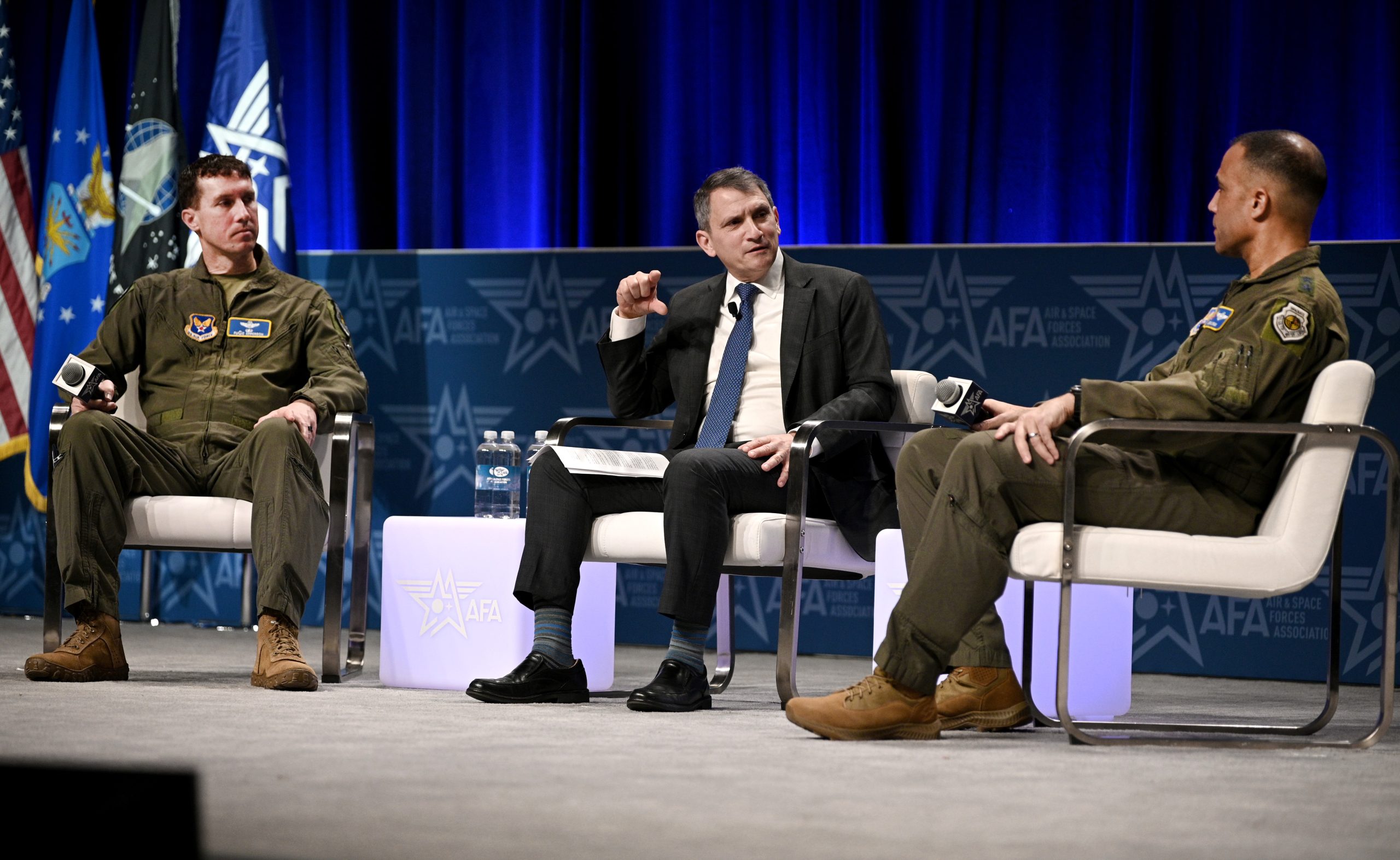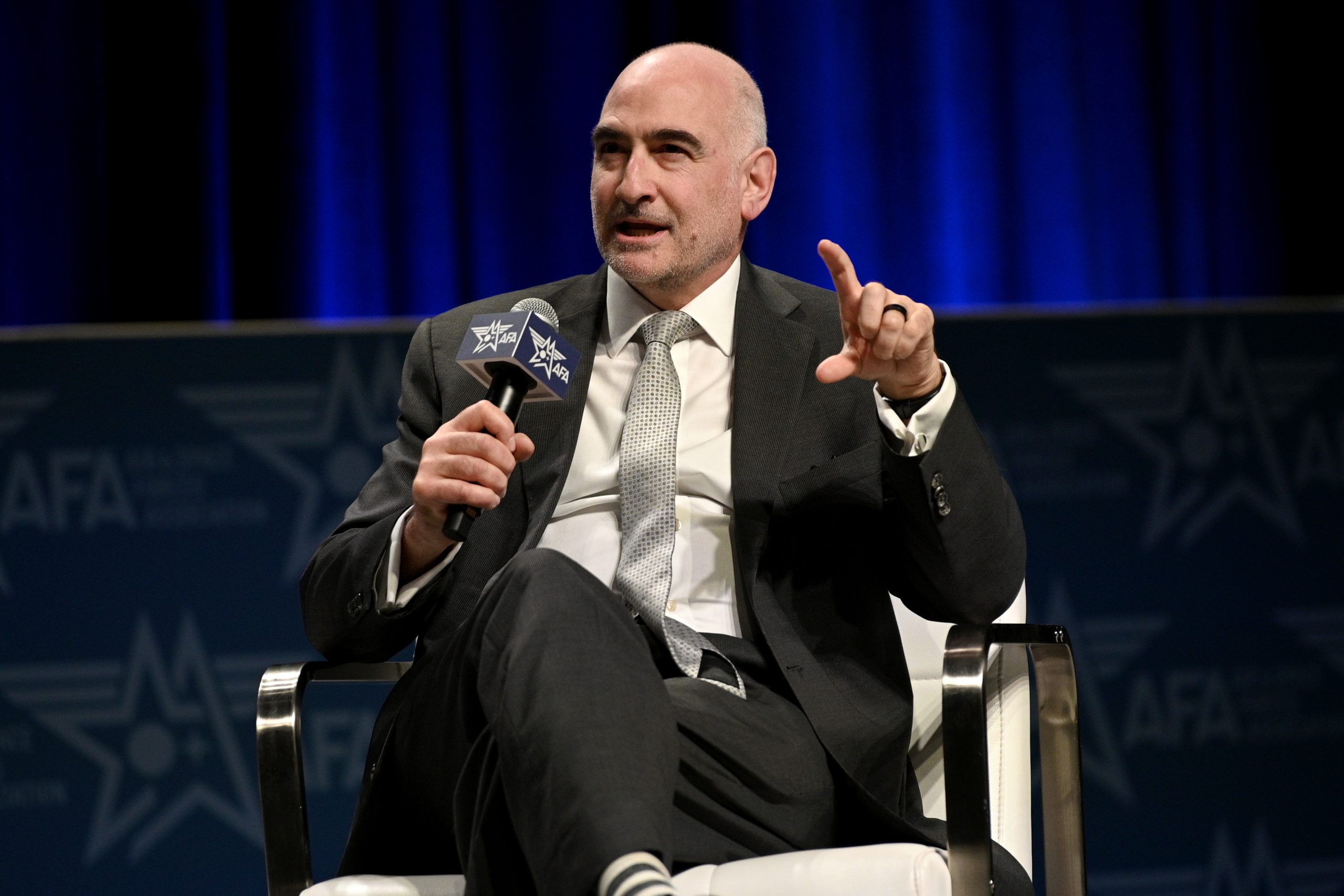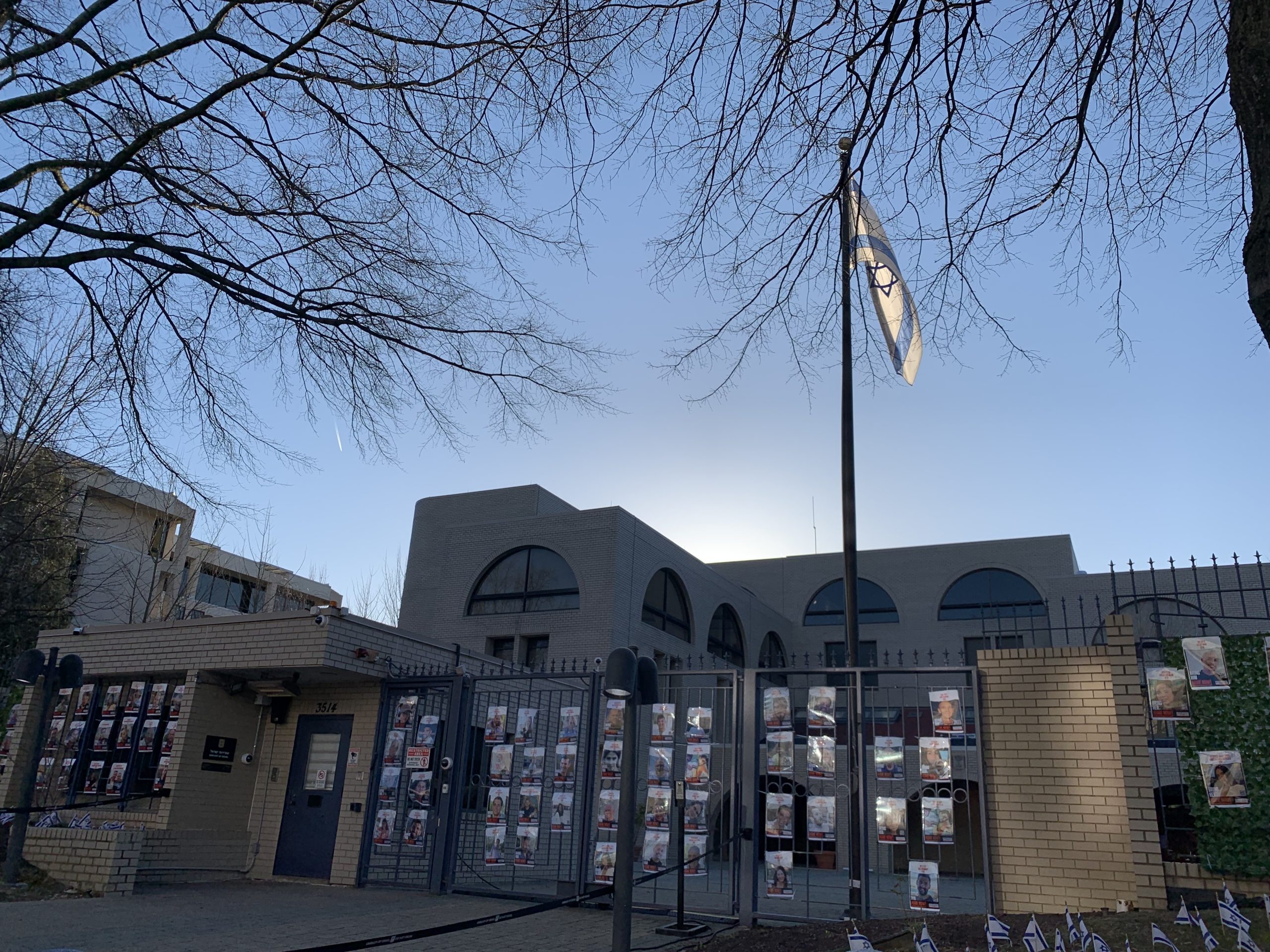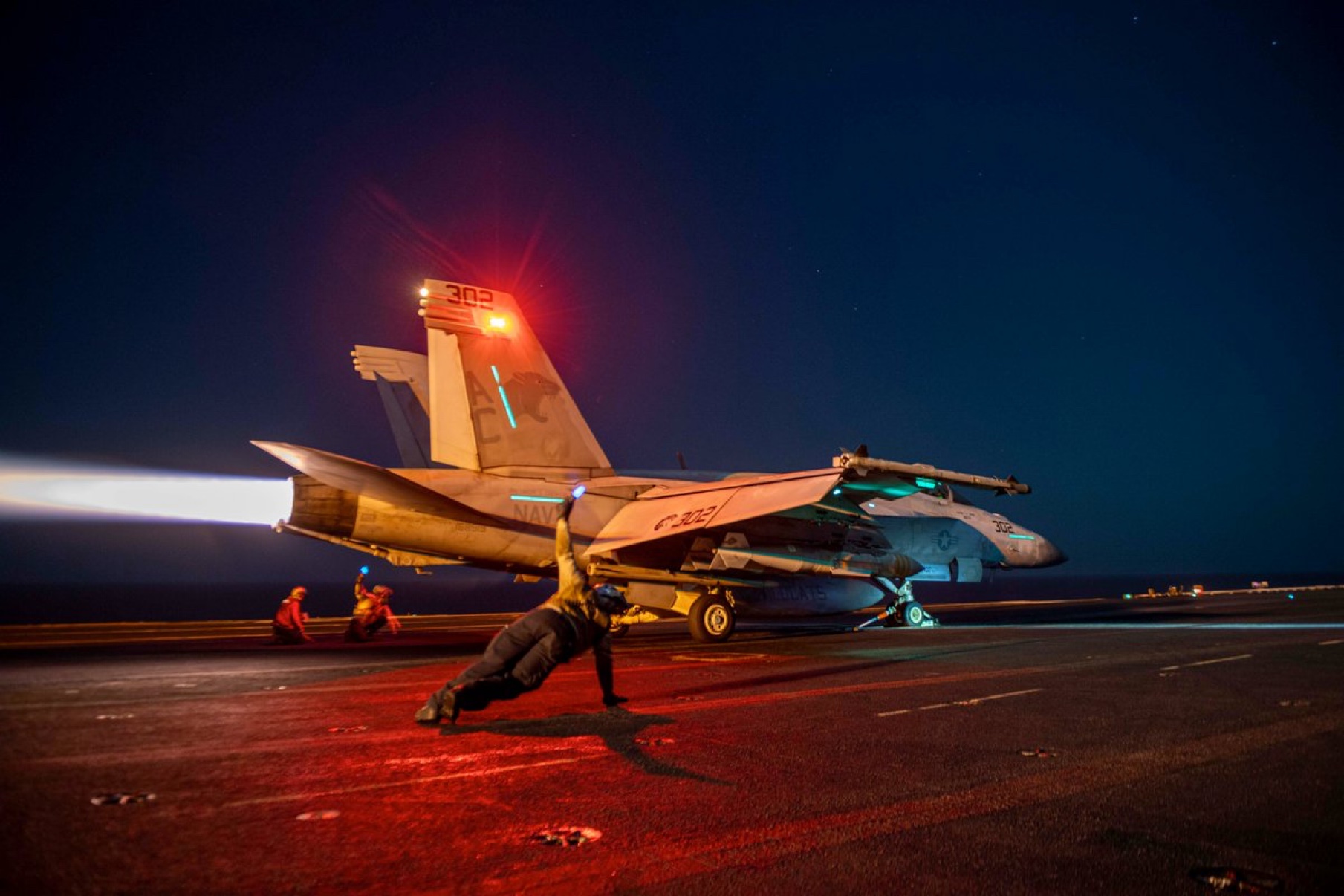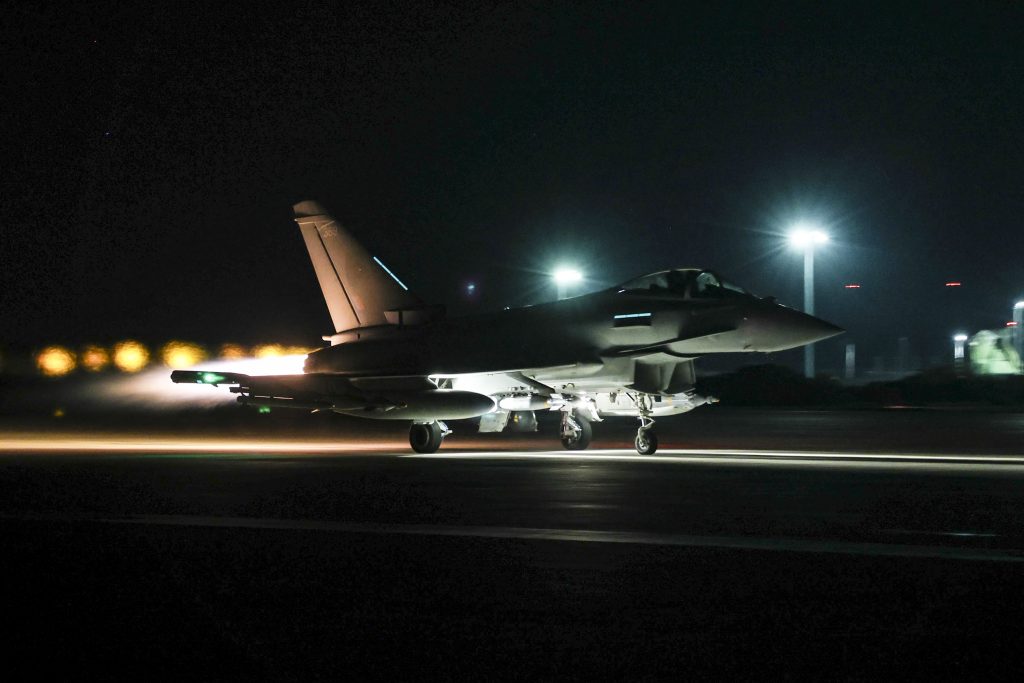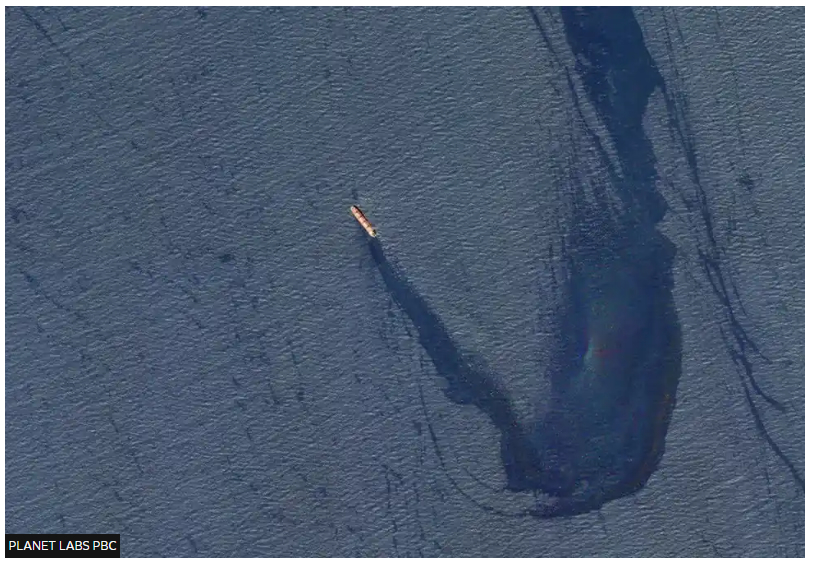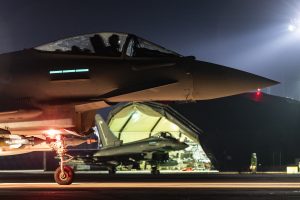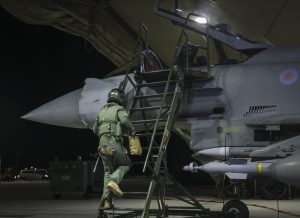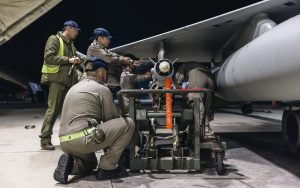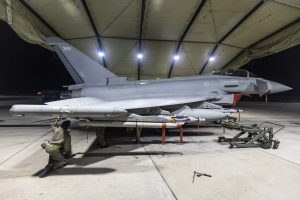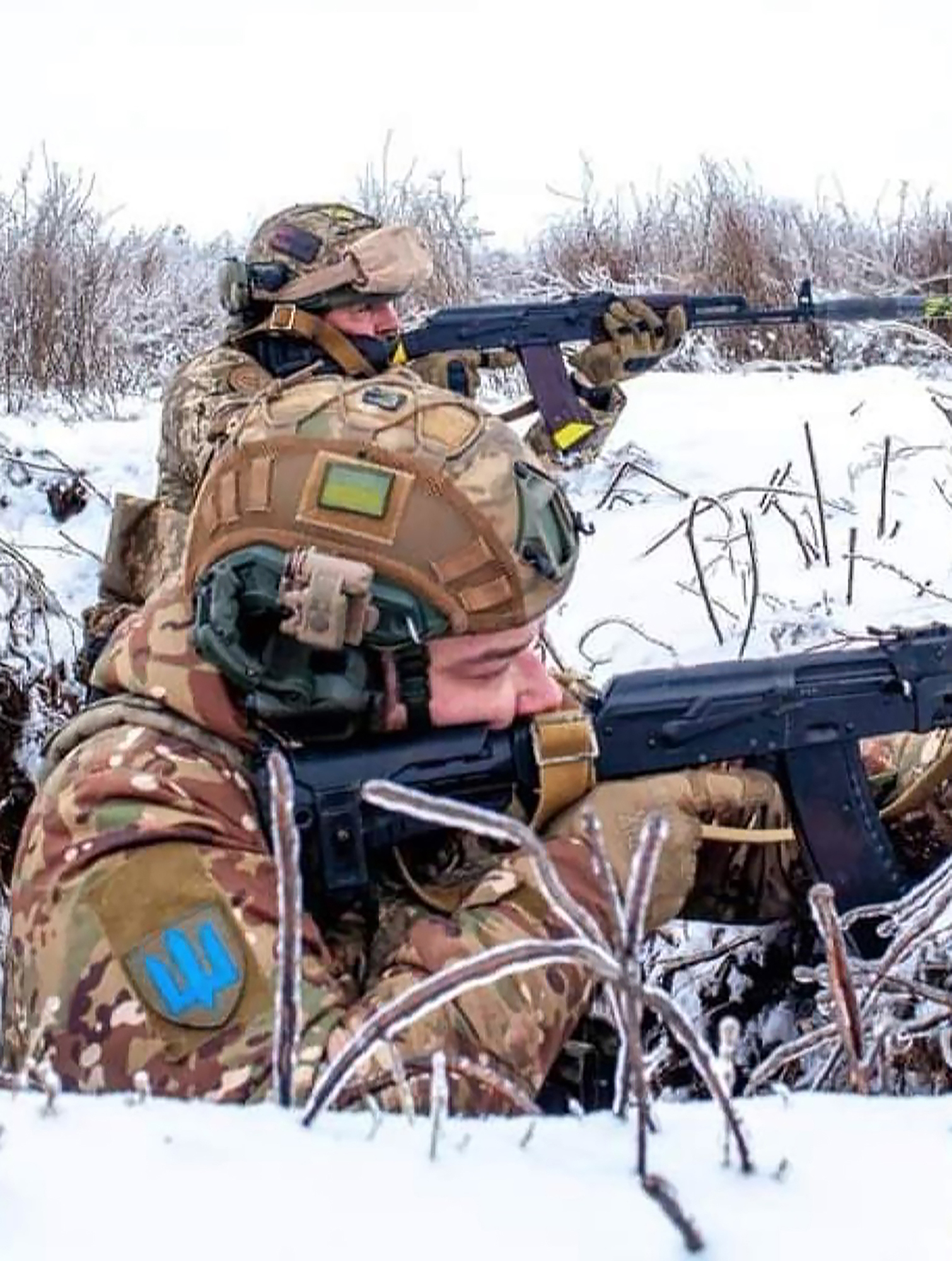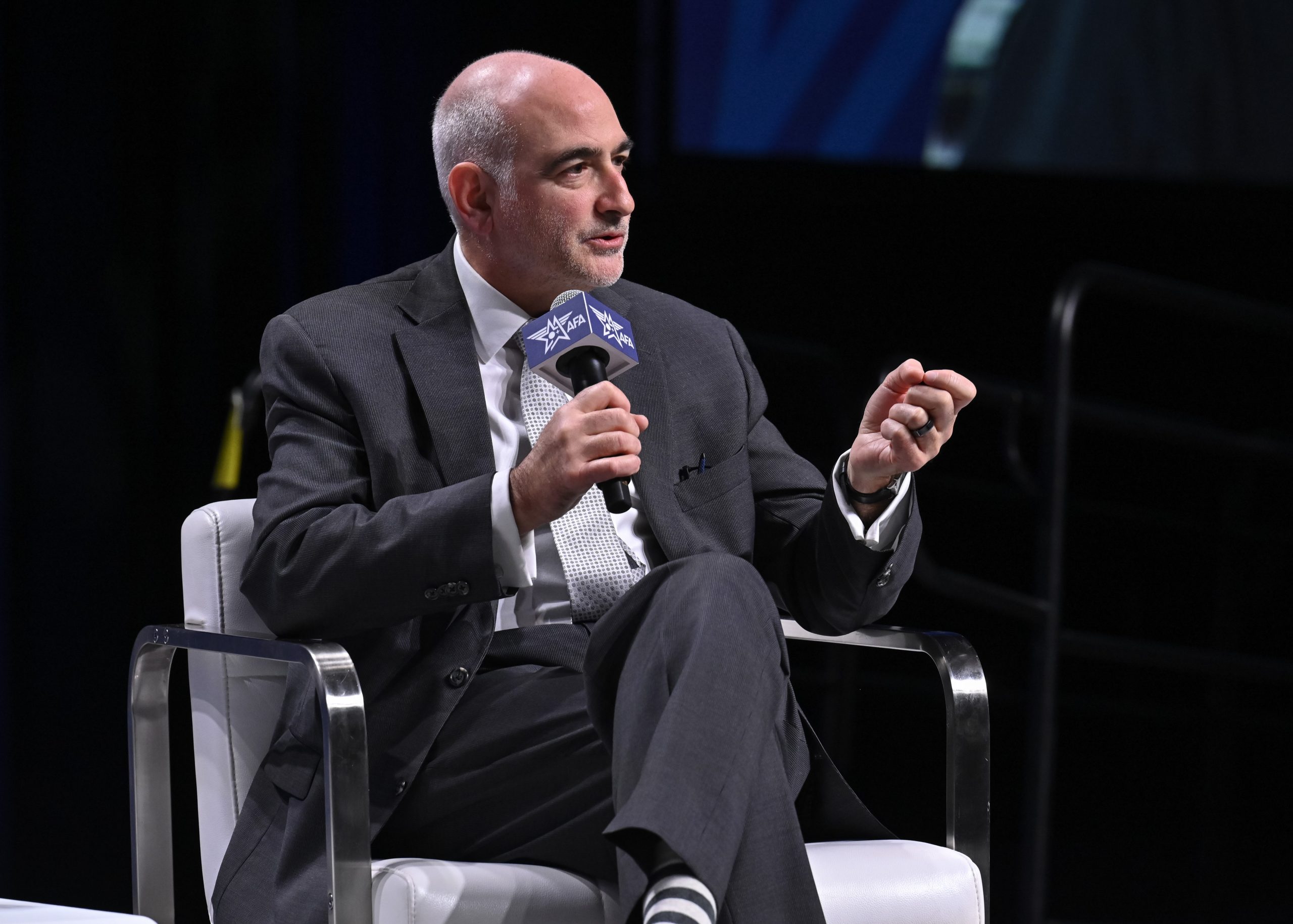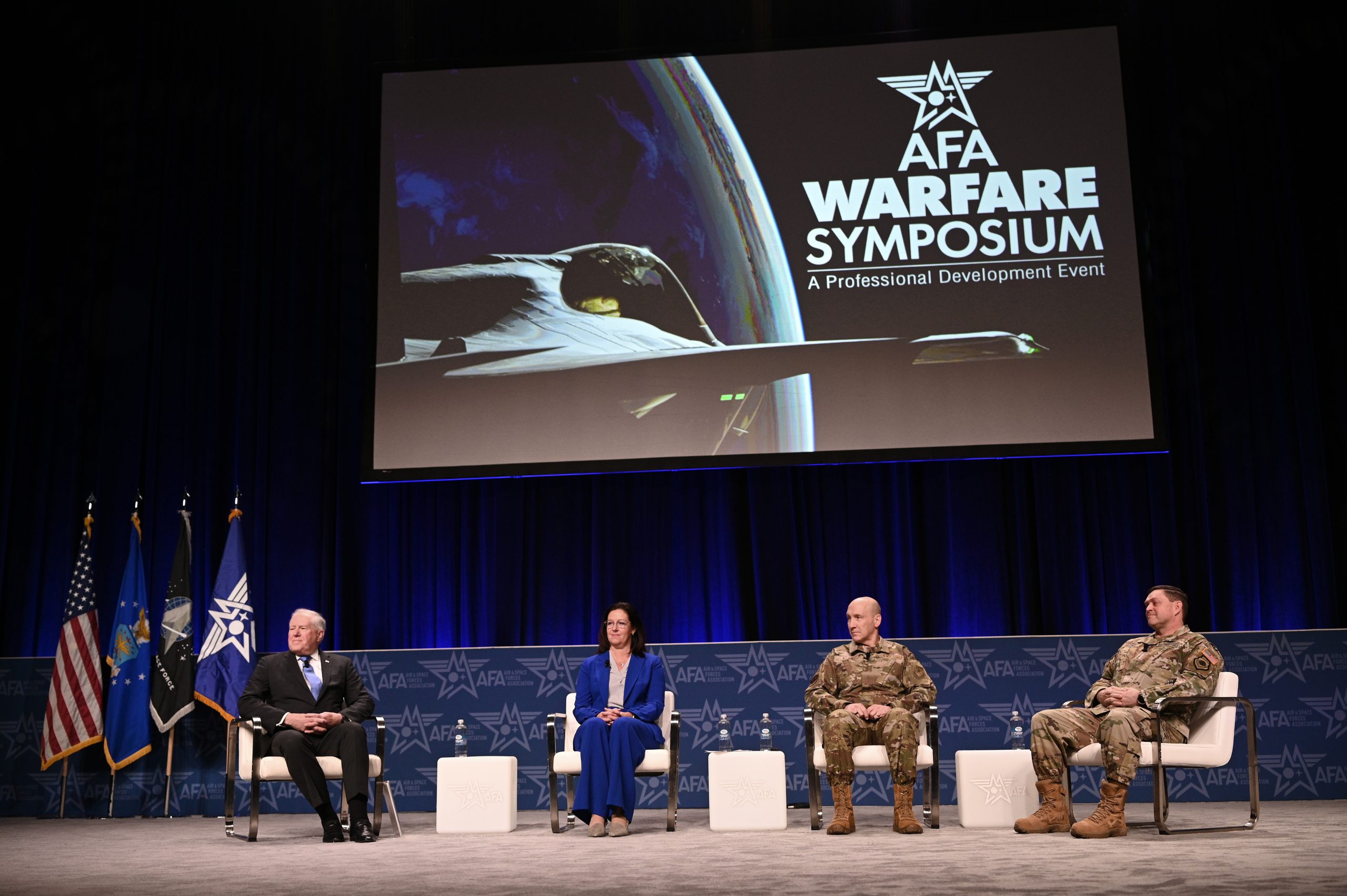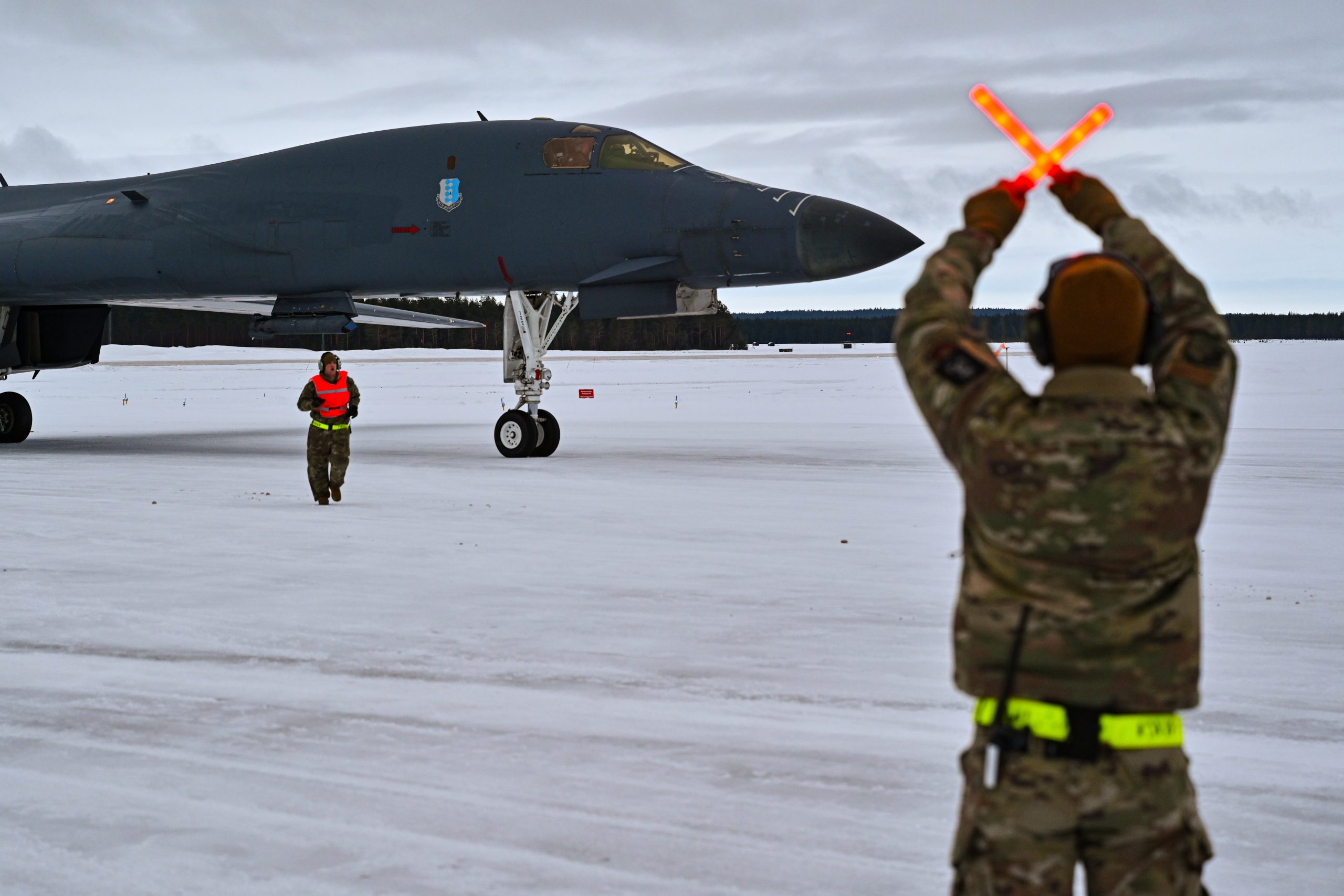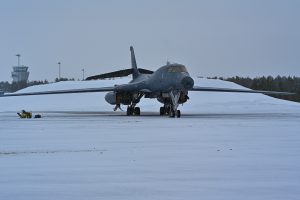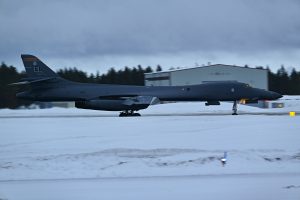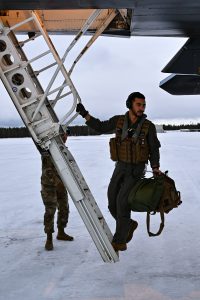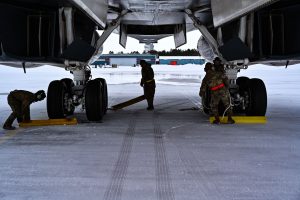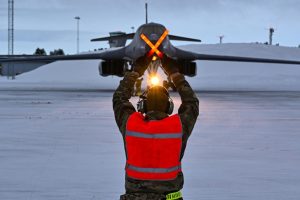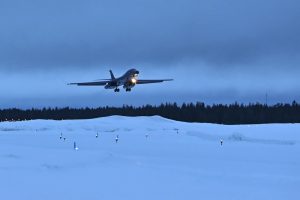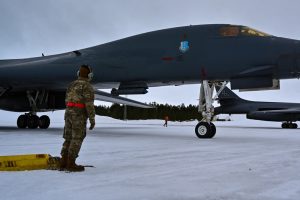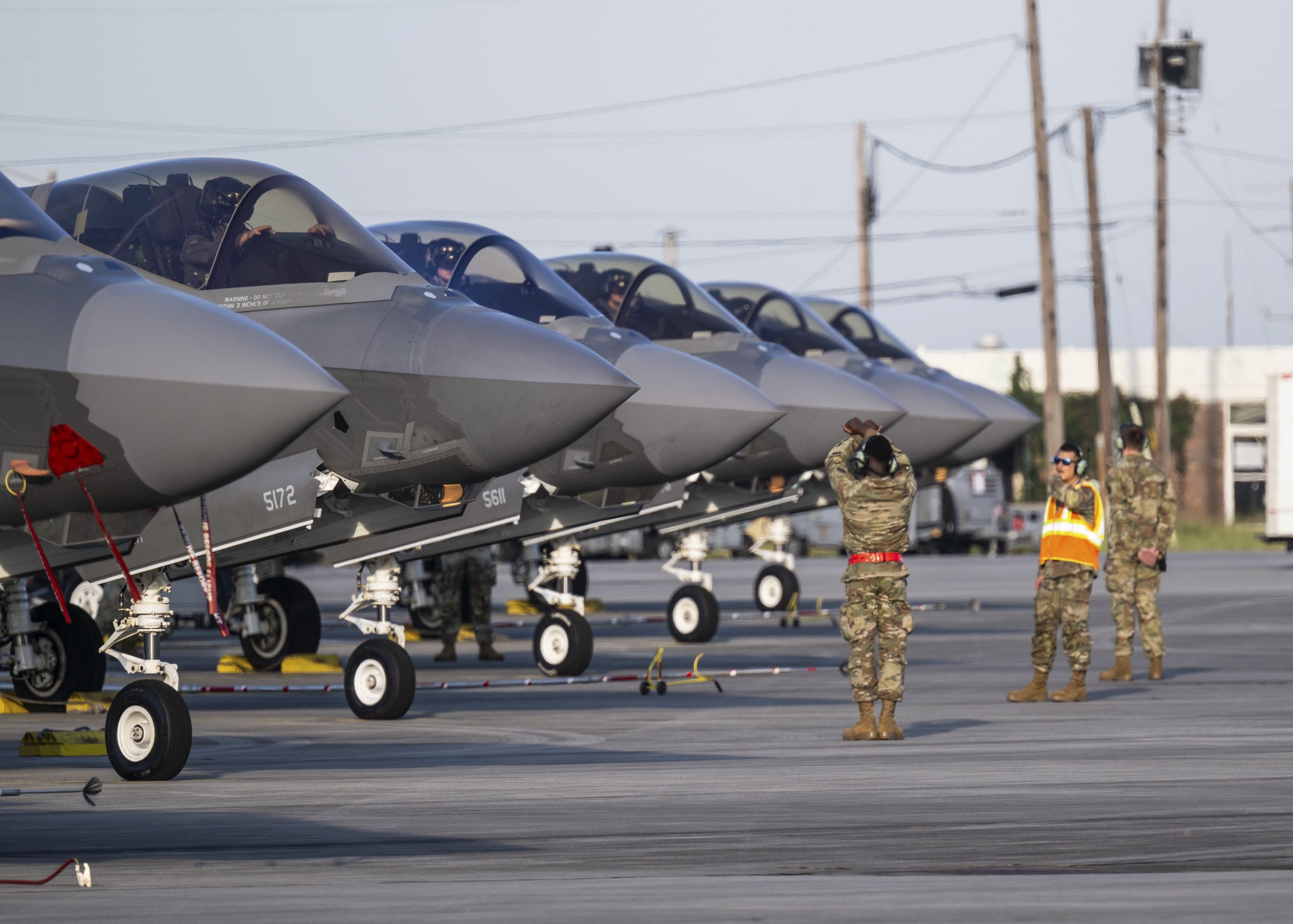Lt. Gen. Adrian L. Spain, deputy chief of staff for operations, and Brig. Gen. David C. Epperson, director of current operations, spoke with Air & Space Forces Magazine editor-in-chief Tobias Naegele at the AFA Warfare Symposium on Feb. 13, 2024 about Air Task Forces, Combat Wings, and the Air Force Force Generation Model—all things that will affect Airmen’s deployments for years to come.
Watch the video or read the transcript below, made possible through the sponsorship of Schneider Electric.

Tobias Naegele:
Good morning. So among the highest interest items after Warrant Officers is deployments from what we’ve seen on traffic on our website. We’ve got just the right couple of people here to talk to us about changing the way the Air Force is deploying. We have the A3, Lt. Gen. Adrian Spain and Brig. Gen. Dave Epperson, and these guys are rebuilding the way the Air Force is going to build out deployments in the future.
So we’ve heard a lot about task forces. We started hearing about task forces last summer. The Air Task Force was going to be the new thing. And now we have heard about combat wings. And what I’d really like you guys to do is to unwrap that for us. And as a warning to everybody, you will be educated on a whole new set of acronyms that will be totally confusing. So I’ve asked them not to overdo it on the acronyms and to just try to use the whole phrases and then we’ll get to the acronyms by the end, and then you’ll know the difference between, well, I won’t even get into them. I’m going to get them wrong. So let’s just start. Air Task Force—what is it? And then how is it different from the wings that we’re going to go to?
Lt. Gen. Adrian L. Spain:
Can everybody hear me? I think this is on. Great, thanks. Yeah, thanks a lot, Tobias. I really appreciate you being here. And thanks to the AFA for hosting and allowing us to talk about this really important topic for the Air Force and for our Airmen. I’d like to start by backing it up a little bit before jumping right into Air Task Forces. We’ve been on this journey, this evolution of how we deploy for really a long time. Ten years ago as a group commander, we were talking about it in terms of white space, “Hey, how do we build in more white space and more predictability for our units?” Five to seven years ago, we started talking about it in terms of, “Hey, how do I deploy in teams to build up mutual support, camaraderie, war fighting ethos before I get there? And I have a grouping and a core of folks who can help take care of each other when we descend upon a deployed location in theater and not show up alone.”
And in this journey from Gen. Goldfein, “Hey, we’re going to do some men teaming here. Instead of sending people out as individuals, we’re going to send them out in a men of three.” That was the goal to build some of that. The expeditionary air base, you almost got me there on the acronym, expeditionary air base is a natural evolution of that where we’re still trying to build up bigger teams from fewer places to go to rotational locations and execute a war fighting mission that have built up some comradery and familiarity and some training together at the command level in the expeditionary air base, while still also crowdsourcing a decent amount of the remaining support that go into these rotational locations. It’s important to remember also during that time, we never got relief from the deployments. So as we evolved over time, we had to really continue and figure out how to do this while we still supported a hot fight in CENTCOM and while things got hotter around the world in different places.
And so it had to be slow and steady over time to build this up. And the expeditionary air bases were a natural evolution of that. And then the Air Task Forces from that was really a clean sheet look from the XABs, from the expeditionary air bases, to figure out a better way to consolidate more, have fewer locations, bigger teams, train them together for a distinct period of time before they all went to the same place and executed a war fighting mission. And so the Air Task Forces and the elements of the Air Task Forces do that for us. They don’t all come from the same base currently, but they do come from many fewer locations, bigger teams that know each other, that train together for 12 to 18 months before they’re in an available phase as far as the Air Force Force Generation model is concerned. And then they deploy together.
We’re in the middle of the expeditionary air bases right now. The first tranche of the XABs happened in October, so we’re deploying this way now with the expeditionary air bases. The first tranche of Air Task Forces, the commanders are selected, they will begin their training this summer to deploy in the fall of 25. So 26.1 is when the Air Task Force has three elements, two that will go to CENTCOM, one that will go to the Pacific, and we’ll deploy in that model, which brings us to the combat wings.
So what we described through that evolution was really about rotational forces. The Air Task Force that we tried to put together or that we put together really spoke to an evolution of rotational forces, but that was also applicable for standing forces and theater forces. The combat wings really speaks to the remainder of the force. How are we going to define each of these elements that are standing in addition to the rotational forces that the Air Task Force represents now and really in the future? I think there’s still plenty of work to be done in terms of the interplay between Air Task Force and the combat wings, but that’s the evolution and that’s how we got here and that’s what we’re trying to really do is build war fighting effectiveness over time with coherent teams that meet the attributes that the chief talked about yesterday or over the last couple of days for this current strategic environment and the one going into the future.
Tobias Naegele:
So let’s break down what are the elements of an Air Task Force and then how those are evolving? You’re getting lessons already now that you’re applying, so how will that inform what you’re doing with the combat air wings?
Brig. Gen. David C. Epperson:
Yeah, absolutely. So as you look at it, the chief talked about when he introduced this, that you think of the command layer, you think of the mission layer and the sustaining layer. And so those are really the elements that we’re building together in this. For the Air Task Force itself, we have a command element and we have an air staff that falls underneath them that executes that C2 layer. Beneath that, you’ll have a mission layer, which will be a fighter squadron, a bomber squadron, an airlift squadron that we will deploy out. And then the final layer is that combat service support layer, and that’s the layer that’s going to create the base operating support.
So at a lot of these locations, especially in CENTCOM, the Air Force is responsible to run that base and make sure that the airfield is up and running and we’re caring for all the personnel there. And that base operating support level is what we will accomplish that. Under the Air Task Force, what we’ve done is we’ve located that command element at one location and they will show up as Gen. Spain said, the start of this summer. For the sustaining layer, those will be in teams of a 100 to 150 people. Be it two to three bases that will then come together when it’s time for deployment.
Tobias Naegele:
So they’ll train separately. But the longer term view would be that these wings will be a more cohesive unit, at least in most cases, in one location.
Brig. Gen. David C. Epperson:
So the way that we plan on doing it is, as we talked about, this is spiral development. With the expeditionary air base, we have a core nucleus that is training together and the rest of it is converging at a deployed location. With the Air Task Force, we’re really leveraging the Air Force Force Generation cycle. And so that combat sustaining layer, those teams of a 100 to 150 personnel will come together in the prepare phase, which is a year prior to them being available to commit. During that time, they will train together at that unit, they’ll develop those Mission Ready Airmen skills, they’ll learn the different tasks that their entire team is working on, and they will, instead of being completely functionally aligned, they’ll start to become mission aligned and mission focused. The prepare phase will last for six months, and then we go into the certify phase. During that certify phase, the vision is that those combat service support teams from different installations will come together and operate during exercises and certification events.
So the whole team of that ATF will come together at some point multiple times before they deploy down range. I think what we’ve started to learn from the expeditionary air bases, as Gen. Spain said, those deployed in October, and we all know that on October 7th, CENTCOM heated up based on what happened with Israel. And we took immediate lessons from that. And one of the commanders that deployed as an expeditionary airbase commander, what he said was he was able to operate at the speed of trust from the second they got on the ground. And that’s really what we’re trying to get to when we talk to Air Task Forces. And then when we continue this spiral development towards deployable combat wings, now all of that structure is at one location training together throughout the entire Air Force Force Generation cycle. So they know how to work together, the command and control knows and understands all the elements, and they really can hit the ground running.
Tobias Naegele:
So you’ve mentioned Mission Ready Airmen and Agile Combat Employment underscores everything that you’re doing. This is built for ACE. So talk about how we get from here to there in terms of that ACE preparation. Those Deployable Combat Wings are going to pick up and go as a unit to one or multiple locations and operate like that.
Lt. Gen. Adrian L. Spain:
Yeah, so I think that there’s a couple of things in that question. One, the ACE construct is a schema maneuver to enable war fighting effectiveness for the Air Force. The core tenets of that, the core skill sets of that we will train to, in every one of our war fighting and every one of our war fighting missions. Inside the Air Task Force, there are elements that enable ACE operations, but within the scheme of maneuver of a combatant commander. So we’re going to fall in on a campaign that is either heating up or ongoing, and the ACE, Agile Combat Employment, Execution will enable that schema maneuver.
The Deployable Combat Wing will absolutely have the elements required, and the intent is to fully resource the Deployable Combat Wing to enable all of its war fighting missions and functions and responsibilities to include agile combat employment and either falling in on a single place and hub and spoken out of a single place or falling in on multiple places depending on what the combat and commander needs going forward. But as a core skillset for the Air Force going forward, that Agile combat employment is absolutely baked in and it’s expected. We will build through the training cycle opportunities to stress those units, ability to operate in that environment distributed and aggregating and continue to build that out as they get ready to join to get into their available phase.
Tobias Naegele:
So we’re going to have three kinds of combat wings deployable in place, and then Force Generation Wings. I’d like you to describe those and you guys can jump in and play off each other, describe the differences and then it would be helpful, I think, for people here to understand how they might fit into that. So an example of existing wings or elements and how they may contribute to those three.
Lt. Gen. Adrian L. Spain:
Yeah, so the three combat wings that we’re describing are Deployable Combat Wings, DCWs, Combat-Generation Wings, CGWs and In-Place Combat Wings, which are ICWs. DCW would look a little bit like a mountain home. There’s still a lot of work to be done on this and so we haven’t defined particular wings at this point, but a place like a mountain home where you have all the resources required at your disposal, the entire wing is under 1C2 structure or a common C2 structure with a base support element that is intended to pick up and go in its entirety as a unit of action.
Resource to do just that, trained to do just that. And the whole thing leaves and we leave behind a min level of support for the installation and the folks that are left behind, but there isn’t mission that’s left behind there in that sense. A Combat-Generation Wing would be a little different. You have elements that would deploy, but the whole wing isn’t going to deploy and it won’t be resourced to do that. Probably an imperfect example is a base like Travis where there are lots of missions going on, but some elements of that wing are going to leave to go forward into a war fighting mission somewhere in a theater.
Tobias Naegele:
And they’re going to plug into a DCW.
Lt. Gen. Adrian L. Spain:
And they will plug into a command and control structure as defined by the combatant commander. And the beauty of the Air Task Forces and the combat wings is, and I think we’re going to get to this in a little bit, but going either to Europe or to the Pacific or to CENTCOM or to AFRICOM, it’s designed to fit into any C2 structure really and fall in on the prevailing command and control apparatus of the combatant commander and the schema maneuver that they define. And once we know where to plug in, it has the elements required to both take orders and to give orders and to operate off a mission command and commander’s intent if it’s disconnected. And then the in place combat wing would be a wing like Malmstrom, you’re going to execute your combat missions from home station. You’re not going to deploy forward. You’ll need a different set of resources to be able to operate in that mode from there.
Tobias Naegele:
So you’re going to have to identify in this process who’s got what? Because some of those wings are not actually resourced to do what you need them to do, and they’re going to have holes. And then I guess you’re hoping that you’re going to find some pieces that you can plug in without disrupting operations somewhere else.
Brig. Gen. David C. Epperson:
Yeah. Ultimately, as the chief and the secretary alluded to, we know what we’re trying to accomplish, and now there’s a lot of work still to be done on the exact how of it. And so the next piece of it is to really look across the force and to identify which ones of those wings are going to be a Deployable Combat Wing, who will be a Combat-Generation Wing and who will be an In-Place combat wing. And once we have that, then we’ll start to look at what are the resources required. Initially as we step into this, we will try to do things as efficiently as we can, but we’ll realize that it’s not going to be perfect from the get go. It’s going to take some time. It’s going to take some evolution as we move through this process to really make sure that we know where all the right resources are and how much they need.
And I think that’s what’s good about this spiral development. By using the Air Task Force and deploying those, we start to see better what is required in the training environment for a Deployable Combat Wing. Do we have the manning and the personnel identified correctly to be in that sustaining layer to operate a base at a forward location? And so through this spiral development, we’ll continue to refine based on what we’re seeing in the expedition airbase, the Air Task Force to help us develop what that will look like when we get to the deployable combat wings and the In-Place Wings.
Lt. Gen. Adrian L. Spain:
Hey, Tobias, if I can jump in, one of the things that this is really helpful in, and the secretary’s had us working on things like this for the last five months or so, and one of the observations we had pretty early on is that there are some areas of the Air Force we don’t really see ourselves very well. We can’t define it really well. We haven’t structured it in a way that’s easily describable to others when we’re trying to articulate risk, readiness and capacity. And so when we start to identify to include, “Hey, what is a deployable combat wing and what’s an in place combat wing?” And we know what those things look like in our minds as Airmen because we’ve operated in and through them for our whole careers, but outside of that, that may not be true, and it may also not be true that we’ve resourced them in that same way from an installation perspective.
And so what this allows us to do internally is say, “Hey, I have a different resourcing requirement for a Deployable Combat Wing than a Combat-Generation Wing than an In-Place Combat Wing.” And have I resourced them to that requirement? No. Or yes, yeah, we have. We’ve done it perfectly or nope, we haven’t done it perfectly. So now we can have an internal dialogue that’s meaningful and bounded by the structures and the attributes that we value to say, “Hey, this is what I need this wing to be able to do, and therefore I’m going to provide the resources required in order to get there.” And if I don’t have them in the right places, which to your point, we probably won’t to start when we figure this out, we are where we are with the resources that we have. We’ll probably be a little bit imperfectly postured. But now I can start making either the requests or the advocacy for those resources to get us whole or to move folks around as if necessary, to create whole capabilities as opposed to partial capabilities.
Tobias Naegele:
So let’s pick up from that for a moment. The Army presents forces as brigade combat teams, and they, I don’t know, 50 whatever brigade combat teams, and everybody knows that, or at least the joint staff knows that and understands that. And the Marines have Marine Expeditionary Units, and the Navy has carrier battle groups, and they have a really good way of saying, “I’ve got this one right now, and if you don’t, I can’t put another one in the Arabian Sea until whenever.”
The Air Force has just been, “Yeah, we can do that, we can do that. We can do that in twos and threes and fours and squadrons and task forces.” And that’s worn you out over 20 some years. I mean, that’s why the force is sort of perpetually stretched, perpetually tired, and yet always able to deliver. This is going to actually tell the joint staff that you don’t have forces available or you might not, or there’s going to be a cost. And that’s been a really big challenge. A, is there a demand signal for that? And B, how will they respond to this changing approach?
Lt. Gen. Adrian L. Spain:
Yeah, that’s a great question and we’ve actually been on this path for a little bit now in some force elements. So I think number one, anytime you can define risk better, the joint staff is willing and wants to hear that. And the secretary, frankly, who is the ultimate risk owner, the secretary of defense, wants to know where he’s accepting risk or not accepting risk deliberately. I’d say one of the areas that this helps us do is define the risk that is being accepted more sufficiently.
For ourselves, we can articulate it more effectively and advocate for a particular method or means and for the secretary of defense and the department to say, “Hey, is this risk that you are willing to take now? Because there is a cost,” unlike previously where we had a hard time defining the cost of employing in the ways that we did before because I couldn’t articulate the full risk. I had force elements, unit type codes. We’re not going into acronyms, I didn’t do that to you. So we have these small aggregations of niche capabilities—
Tobias Naegele:
Like 3,000.
Lt. Gen. Adrian L. Spain:
—all across the Air Force, which is roughly equivalent to the number that the army has. Totally different scale in terms of numbers, but we broke ourselves up into these little tiny pieces. But going back to the attributes required over the last 30 years, what was valued of the Air Force was flexibility and the ability to respond to a need not as whole intact mission capabilities, but in really smaller, compact-
Tobias Naegele:
Micro units of action.
Lt. Gen. Adrian L. Spain:
Micro units or specific elements that were required for a specific amount of time. But I didn’t need the whole apparatus to come forward to do that. And that was the value over the last 30 years that the Air Force brought to the table. Hey, we were flexible enough to adjust and we organized ourselves that way. That attribute is not going to work in this current strategic environment. We know that. We’ve seen that. We’ve watched this evolution occur over the last five to 10 years to get us to where we are now and going forward, we know we need to be on this path, which is great that we are continuing to march down it.
We know, as Fuji mentioned, it’s going to be imperfect, but we have to go this way. The fight of the future is about bringing whole capability into theaters to either fight alongside our Airmen who are already there and Guardians and Soldiers and Sailors and Coast Guardsmen and civilians. Getting into theater and fighting alongside them, and a treating forces because this fight is going to be different than the ones that we’ve been in for the last 30 years. And then backfilling those forces with more whole capability that has to come forward to continue fighting and piecemealing it and micro units, to use your phrase, and aggregating from a hundred different places, literally as we’ve done in CENTCOM.
To descend upon a problem and figure it out once you get in that location is not going to work in this environment and we recognize that. And really that’s the impetus for the change is, “Hey, this is about war fighting effectiveness. Yes, it helps us to articulate risk better. That’s absolutely true. Yes, it helps us to articulate capability and capacity better, but this is about war fighting effectiveness, and the next fight is not going to be the same fight as the one that we’ve been executing for the last 30 years.”
Tobias Naegele:
So this is going to be hard. And there are folks out there who will say, you’re putting extra burden on Airmen, extra burden on commanders to work through a series of changes that are really about the joint force and about the combatant commanders, and that shouldn’t be their problem. But you see a rainbow or gold at the end of the rainbow there. So why is it worth it?
Brig. Gen. David C. Epperson:
I think besides the, we need to do this for optimization, I think why is it worth it. Historically, when I go around and I’ve talked to a number of large groups of people, one of the questions I get from the combat service support area is, “Well, Air Force Force Generation is really about aircraft units, it’s about the fighter squadron, it’s about the bomber squadron, it’s about the airlift squadron and how do they go through the Force Generation cycle to be ready to be available to commit?” The intent for the Air Force Force Generation cycle all along was to apply to the entire Air Force, not just that one piece of the Air Force. And so what this does, especially through the Air Task Force and then ultimately into the deployable combat wings like I talked about earlier, we actually take those Airmen and we have them start to focus on the deployment a year out.
So when they hit that prepare phase and AFFORGEN cycle, they are starting to actually prepare. It gives them that predictability. Right now, you go back to 23 and even part of what we’re doing for the expeditionary air bases here in 24, some of those Airmen, although they might be in a bucket that says, this is your potential deployment timeline, they don’t know what unit, what location, and whether or not they’ll get tapped. As we move forward, they will have that predictability because they will go into a combat service support team that they know in one year I’m going to deploy, and they’ll know exactly what location they’re going to deploy to.
And so they can provide that continuity and the ability to truly train to what we’re asking them to do and to build that team that other units like a maintenance AMU, Aircraft Maintenance Unit or something like that where they build that teamwork all the time. We now get that across the entire base operating support mission function and build those mission focused teams from the beginning. So I think it’ll provide that predictability and truly prepare our Airmen for what we’re asking them to do down range.
Lt. Gen. Adrian L. Spain:
Here’s put a thought in your head on this one. So part of what we also valued over the last 30 years was efficiency and garrison function over deployed mission. So in the combat service support arena, when you prepared to deploy, you got pulled out of your squadron as an individual, you started to do your individual training to get to your deployed location. You deployed as a single, you showed up there, you joined a team. You had to build comradery with that team, learn what your function was there. But the wing back home kept going exactly as the same. Because all those, the institutions there and the installation functions were valued and consistency and efficiency in the installation was valued.
Imagine if that wing every day was focused on war fighting mission. So there’s installation functions that’s occurring, but what we value and what we favor and privilege is the war fighting mission, regardless of what’s quadrant you happen to be in or what your function is. So now your comm troops, your security forces, your CE teams are focused on the same exact mission that the mission generation for settlement is focused on. It’s focused on the commander’s ability to execute that mission from an austere location or to work from a hub and a spoke. And you’re building those skill sets every day. Today, not today, we’re getting better at this with the Mission Ready Airmen and Multi Capable Airmen efforts as we work through the evolutions there and individual ready training, ready Airman training, excuse me.
But the focus is still on the installation function or had been still on the installation function where now your focus is on your war fighting function. And I still have installation work to do, but it’s not the primary thing that I’m preparing for every day. I’ll use the analogy as a flyer. I had a daily flying schedule, I’d go do a local sortie and I was training to a high end threat on a local sortie day to day. There’s no equivalent for your FSS troop in a squadron historically organized around installation functions. A daily sortie for that troop is different in a mission environment than it is at the installation, and they don’t have the opportunity to go train to that. Working with the MSGs that I’ve grown up with, we used to talk to those guys and say thank you all the time because their reward for great work is just another stack of work. They don’t get to finish an exercise. They don’t get to cross a finish line.
Its, “Hey, thank you for doing such a great job. Here’s your incentive,” another piece of paper or another project or another contract or another travel voucher, so it doesn’t ever end. But now they get to feel like in this environment that they’re a part of this same team. I am connected to the mission in a way that we haven’t experienced in the Air Force in a very long time. And so I’m pretty excited about that element of it. That everybody… You don’t have people across the other side of the base that say, “Hey, are we flying F-16 over there at Langley? I haven’t been over to the flight line.” And vice versa. Hey, I only go over there when I need a lot of help. This is our team. Those are my maintainers, that’s my comm troop, that’s my CE troop, that’s my pilot, that’s my commander. Those are really important things and concepts that this allows us to get to. And then when you have to go into the fight, you’re going in with a team that’s built that bond in a day-to-day model that we don’t replicate currently.
Tobias Naegele:
So last night when we were talking, Fuji said there is a secret efficiency to those Mission Ready Airmen because they’re going to be able to do more things. And maybe that means in some cases you don’t need as many people because you don’t need one person to do this one job. You can have one person who can do a couple of different things for you. Talk about that and how that might, because you don’t really know yet how that’s going to affect things, do you?
Brig. Gen. David C. Epperson:
Right. We’re working through that right now, and part of the training plan that we’re developing is identifying those areas where we can broaden our Airmen and really look at that Mission Ready Airmen skillset. When I was a group commander and in a deployed location, sometimes I would go around and visit my Airmen and I might walk into one area at 10:00 a.m. and talk to an Airman and they’re like, “How’s it going?” “Oh, great. I finished my work at 9:30. I’m hanging out. I’m on duty until four this afternoon, but everything’s doing okay. I miss my family,” and that kind of stuff. I’d go somewhere else at 20:00 and talk to another troop that had been working a 14-hour day and jobbing it all day and tell you their motivation was amazing because they truly understood why they were in this deployed environment and what they were doing.
What the Mission Ready Airmen lets us do is to cross level the playing field a little bit so that I don’t have one Airman that only has two hours of working a day and one Airman that has 14 hours of work in a day. I am not asking them to be an expert in a different career field. It’s not like I want somebody to, the easiest example is explosive ordinance disposal team. I don’t want to train somebody else on which red wire to cut.
There’s certain skill sets that are definitely the skillset, but you look at that and depending upon what fight you’re in, that EOD Airmen might not have a full day’s work every day. When something happens and you have an unexploded ordinance, I mean, that is probably the most critical thing on that installation and that’s going to take priority. But the rest of the time that Airman might be able to help the electrician or the HVAC or they might be able to help with airfield repair, there’s things where we can cross level that with the Mission Ready Airmen. And so a lot of people say it’s doing more with less. I don’t think so. I think it’s more optimizing the Airmen that we have and making sure that they have that capability to help across the team.
Tobias Naegele:
So you’re moving. The thing that I think is exciting about the Mission Ready Airman concept is that you’re moving away from an industrial age model assembly line. All you do is pick up this screw, turn it here, move it on. Then you do the next task. And instead you’re saying you can do a whole bunch of things. So it’s every marine, a rifleman in the Marine Corps. Every sailor is a damaged control man in the Navy. Everybody’s got not just a bunch of crappy ancillary duties, but real capability that contributes to the mission, makes them feel more part of it, but also makes greater values to the human being.
Lt. Gen. Adrian L. Spain:
Yeah, you bet. And the other thing that it does is it allows innovation to occur at the lowest level. So when I’m functionally aligned in a functional squadron, I know how to take risk within the function. I don’t know to go help somebody else in a different function because I don’t see them every day. I’m not organized around them. I know what I’m asked to do and I get that job done and I look for things to help out with in that area, but I’m not looking for other things to do. And what this allows us to enable is the power of these Airmen at the lowest levels to go figure out ways to help. And so to Fuji’s point, we don’t know if there’s a resource savings in this or if there’s a resource gain in this or if there’s a resource bill in this.
But what we do know is it empowers Airmen because they connect to the mission in a different way, in a more holistic way, dare I say, a mission over function way from an attributes perspective that allows folks to come up with good ideas on their own and just get after it. And that is going to help us speed up and keep pace with the pace of the next environment that we’re going to have to fight in and through. So the empowerment at that level is going to be really powerful for all of those Airmen support, mission, generation and command, because I can establish intent for the entire organization, organized around a mission that we’ve all trained to together, and an understanding of where I fit in and how I can help most in multiple areas, not just in the area that I went to tech school in.
Tobias Naegele:
So you brought up resourcing, and I think resourcing is really important because the Air Force has had a difficult time articulating and making its case for resources over the past 20 years. There was the sacrifice for the greater team in the wars in Iraq, Afghanistan, but during this period of time, the Air Force has really been under-resourced. And a lot of the resourcing requirement or arguments have been about this weapon system or that weapon system, not about this unit of action or that unit of action. And so this is, in addition to giving the ability to articulate risk, you’re actually going to have the ability to define shortfall and no kidding requirements. I need this in order to deliver this function. That should be really empowering for the force going forward. And probably it’s above most of everybody’s pay grade, maybe except for his, but it’s a really important piece to this because you can explain to your bosses what you need and they can explain to their bosses and to Congress what the requirement is.
Lt. Gen. Adrian L. Spain:
Yeah, that’s right. And with the specificity that we just haven’t been able to do in a very long time. And you can do it in a way that is unemotional and really agnostic of the outcome. Once I’ve defined the unit of action and we’ve defined how many of those that we have and how much capability we have within each mission area, that’s all we have. That’s it. What you decide to do with it is up to you. We would have some recommendations in how we use that, but the combatant commanders can use their formations exactly how they want to use them. The Secretary of Defense can use the formations exactly how he wants to use them, and we can help define the risk. But we only have this many, and if you want us to have more, we have some ideas on that, whether it’s a posturing and where we’re actually physically sitting or whether it’s a resource discussion about gaining more capability, whole units of action and mission areas.
It allows us to have this discussion in a way that’s very easily definable and more like the other services, which should be helpful at the end of the day, regardless of the answer. And over time allows us to be consistent in what it is that we’re actually after. In the past when we’ve had these resource discussions about weapon system X, location Y, it’s been divorced from this unit of action and whole capability discussion, now we can roll it into that discussion and say, “And this is why I need it,” for the combat capability that this combat commander needs that you’re trying to implement with the National Defense Strategy, et cetera. So we can define it in their terms and then it’s a choice and we can keep operating exactly as we have been and will be, or we can get some help.
Tobias Naegele:
So all politics is local and all news is local. You guys got two minutes and you have about 3,000 ambassadors out there who can take this story to their units of action or their unit type codes. Back to the people that they work with and they talk to every day and explain how life is going to change. What are the three things that they need to tell everybody? How do they carry that message forward to say, “Help is on the way,” but more than help is on it. This is how it’s going to change things. This is what everybody needs to know.
Lt. Gen. Adrian L. Spain:
Well, I’ll say a couple of things. One, this is about what we value. We value the Airmen, we value the team and we value the mission. And what we’re trying to continue this evolution toward is a set of conditions that values the Airmen and trains them to be ready for the fight that we know that may come our way, we hope doesn’t, but we need to be prepared for. It values the team and the attributes of the team that we know that will be successful or that needs to be successful in the environment that we’re talking about. And it values the mission effectiveness of that team once it gets to the area that we’re asking it to go in harm’s way or in preparation for harm’s way as a crisis evolves.
And all of these things, while imperfect today are in order to get to that end state and we’re on a path, we need your help in getting there. We value your feedback. We’ve gotten direct feedback on the expeditionary air bases. We need your feedback on the Air Task Forces. We’ll need your feedback on the Deployable Combat Wings, the Combat-Generation Wings and the In-place Combat Wings, so we can make it better faster. But we’re going this direction and it’s to value those things, the Airmen, the team, and the mission readiness that is required for the strategic environment.
Tobias Naegele:
Gen. Epperson, you want to add one more takeaway?
Brig. Gen. David C. Epperson:
I think my boss said it perfectly.
Tobias Naegele:
All right. I think I did it in the wrong order. So that’s what happens. Have a round of applause to a couple of great guys. Thank you very much.
Brig. Gen. David C. Epperson:
Thanks.
Tobias Naegele:
Great job.
